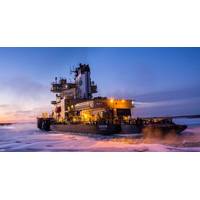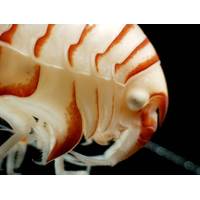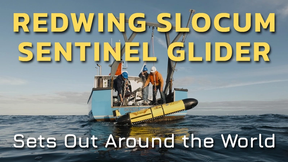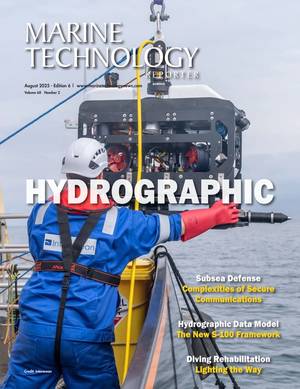
Strong Winds, Calm Seas
a special task within the wind farm’s ecosystem, explained Marius Wirtz, Dipl.-Ing. (FH), Engineer at the German Research Center for Artificial Intelligence (DFKI) and project leader of the AUV team. In addition to DFKI, collaborators include the Alfred Wegener Institute Helmholtz Centre for Polar and Marine Research (AWI), Helmholtz Institute for Functional Marine Biodiversity at the University of Oldenburg (HIFMB), BioConsult SH, the Danish company DHI A/S and the Norwegian company Spoor AS.Ecosystem ExaminationThe AUV team from DFKI will monitor the underwater ecosystem. “The goal

RWE to Employ Innovative Ecosystem Monitoring Tech at Kaskasi Offshore Wind Farm
carbon intensity of monitoring as well as minimizing the impact on marine lifeThe project will be carried out in collaboration with partners including the Helmholtz Institute for Functional Marine Biodiversity at the University of Oldenburg (HIFMB), the Alfred Wegener Institute Helmholtz Centre for Polar and Marine Research (AWI), BioConsult SH, the Danish company DHI and the German Research Centre for Artificial Intelligence (DFKI).The partners plan to share the results on a dedicated online public platform.“As a global leading player in offshore wind, we feel responsible for building

SAMS’ New Sensor Sheds More Light on Ocean Photosynthesis
.As part of the MOSAiC expedition, the German research icebreaker Polarstern was frozen into the icepack of the central Arctic for a year in 2019, in order to investigate the annual cycle of the Arctic climate and ecosystem.The team led by Clara Hoppe from the Alfred Wegener Institute, Helmholtz Centre for Polar and Marine Research (AWI) focused on studying phytoplankton and ice algae. These are responsible for the majority of photosynthesis in the central Arctic. Unexpectedly, the measurements showed that just a few days after the end of the month-long polar night, plant biomass was built up again, for

Scientists Find Micro Plastic in Arctic Ice
. 4 and covered some 2,000 nautical miles.Separately, German and Swiss scientists published a study on Wednesday based on samples from the Arctic, Swiss Alps and Germany that suggested microplastic is being blown vast distances through the air and dumped when it snows.The team from the Helmholtz Centre for Polar and Marine Research found that snow collected on the Norwegian Arctic archipelago of Svalbard contained up to 14,400 particles of plastic per litre. The study found its highest concentration of particles -- 154,000 particles per litre -- near a rural road in the German federal state of Bavaria.Melanie

New Species Found in the North Sea
Sea, usually relate to animals or algae that were newly introduced by human activities. The discovery of a new amphipod species is proof that there are still unknown organisms lurking in the German Bight. A team of scientists around Dr Jan Beermann from the Alfred Wegener Institute, Helmholtz Centre for Polar and Marine Research (AWI) and Dr Michael J. Raupach from the University of Oldenburg, as well as colleagues from the University of Potsdam, now successfully discovered and described a previously overlooked species in the North Sea – a rare event, considering that the region is one of the best-studie
Threat from wandering greenhouse gas
issue of the online journal Scientific Reports. Although this interaction between methane, ocean and ice has a significant influence on climate change, to date it has not been reflected in climate models. In August 2011, the icebreaker Polarstern from the Alfred Wegener Institute, Helmholtz Centre for Polar and Marine Research (AWI) was making its way through the ice-covered Arctic Ocean, on a course that took her just a few hundred kilometres from the North Pole. Back then, AWI geochemist Dr Ellen Damm tested the waters of the High North for the greenhouse gas methane. In an expedition to the same
Litter Levels in the Arctic Depths On the Rise
The Arctic has a serious litter problem: in just ten years, the concentration of marine litter at a deep-sea station in the Arctic Ocean has risen 20-fold. This was recently reported in a study by researchers at the Alfred Wegener Institute, Helmholtz Centre for Polar and Marine Research (AWI). Plastic bags, glass shards and fishing nets: despite its location, far from any urban areas, the amount of litter in the depths of the Arctic Ocean continues to rise, posing a serious threat to its fragile ecosystem. Since 2002, AWI researchers have been documenting the amount of litter at two stations of
Retreating Arctic Coasts Cause Drastic Changes
removed in this process increasingly blur the shallow water areas and release nutrients and pollutants. Yet, the consequences of these processes on life in the coastal zone and on traditional fishing grounds are virtually unknown. Scientists from the Alfred Wegener Institute, Helmholtz Centre for Polar and Marine Research (AWI) urge to focus our attention on the ecological consequences of coastal erosion in the January issue of the journal Nature Climate Change. According to the scientists, an interdisciplinary research program is required, and must involve policy-makers as well as inhabitants
New Satellite Technology Boosts Glacier Research
topmost ice layer of the glaciers and ice sheets from space and to map Their inner structure. in addition, we can therefore measure the changes in the glacier surface with tandem L ", says Professor Angelika Humbert, Head of the Glaciology Section at the Alfred Wegener Institute, Helmholtz Centre for Polar and Marine Research (AWI). For the tandem-L mission, she and her team had INITIALLY Analysed data from the already operating satellites TerraSAR-X and tanDEM-X. On the basis of this, theywere able to develop methods of analysis and filtration That Could be used to understand the origin of the



 August 2025
August 2025





